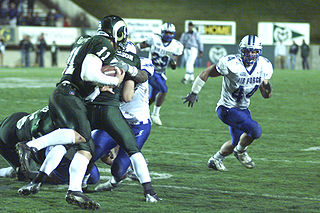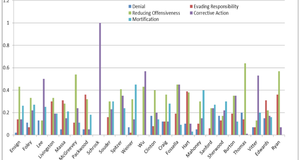This study sought to explore the college athletic landscape through a Crisis Communications perspective. Using William Benoit’s “Theory of Image Restoration” as a framework, this study employed a case-study approach to analyze the image restoration strategies of three high profile college football players following scandals. The study found a consistent use of traditional strategies such as mortification, corrective action, and denial from the athletes and associated parties. This research demonstrates the level of prominence that college athletes have been elevated to and concludes they be recognized from a public relations standpoint accordingly. Given the national attention and loyalty that college athletics receive, this study would provide an important foundation for future research on a rapidly evolving section of society as well.
College athletics have been engrained in American culture for nearly as long as the institutions of higher learning themselves. These programs are more than just participatory sports for students, they are a unique aspect of American society. Zealous fan devotion has elevated college athletics to a level of prominence that is largely unparalleled in the world of American sports.

With a devoted fan base and a national spotlight, college athletics have become extremely profitable as well. Nearly every party involved with college sports, whether it is universities, athletic conferences, coaches, television networks, retailers, even the local communities, make upwards of millions, even billions, through the performance of student-athletes.1 These profits continue to increase as the scope of these programs spreads, with many now referring to the world of college sports as “big business.”2
Scandals have been a consistent presence in sports over the past century, and college athletics are far from being an exception. Scandals involving student athletes have become increasingly commonplace, as the world of college sports has received increasingly more and more spotlight. The causes of these scandals are numerous, although the majority inevitably stem from the NCAA’s strict prohibition of athletes receiving any sort of compensation for their athletic prowess. Regardless, these scandals garner extensive attention and are heavily scrutinized by a variety of parties.
Due to the popularity and profits associated with college athletics, there is a staggering amount of responsibility tied into the actions of these young individuals. The very reputation of universities, companies, and entire communities often go hand in hand with the actions of their athletes. Thus, it is imperative that high-profile scandals involving college athletes are dealt with in a timely and effective manner.
The following study utilizes a case study approach to explore the scandals of three high-profile college football players: Terrelle Pryor of Ohio State University, A.J. Green of the University of Georgia, and Cam Newton of Auburn University. The study then analyzes the image restoration efforts on behalf of each player and compares them with the established literature on the subject.3 In doing so, this study will answer the following research questions and ideally add further depth to the field of sports public relations.
- Do the crisis management efforts of high-profile college athletes coincide with the strategies established by scholars on the subject?
- From a crisis management perspective, should high-profile college athletes be viewed in the same light as professional ones?
- What crisis management strategies are effective in confronting the scandal of a high-profile college athlete?
- Do the involved athletes undertake crisis management efforts, or do the Universities assume control of the situation?
- What caveats are unique to the college athlete when employing a crisis management strategy?
Crises can come in any number of forms. Whether it is organizational, individual, or another manifestation, crises have attracted significant academic attention. As a result, there are a variety of definitions associated with the term “crisis” stemming from established literature.
According to Dan P. Millar and Robert L. Heath, a crisis is “typically defined as an untimely but predictable event that has actual or potential consequences for stakeholders’ interests as well as the reputation of the organization suffering the crisis.”4 Timothy Coombs echoes a similar definition of a crisis as “an unpredictable, major threat that can have a negative effect on the organization, industry, or stakeholders if handled improperly.”5 Steven Fink takes his definition one step further, emphasizing the presence of instability and impending change: “Crisis is an extraordinary event that results in an unstable time or state of affairs in which a decisive change is impending.”6 Other scholars, such as Irvine & Millar and Fearn-Banks, shift the focal point of their definition of the potential outcomes of a scandal, such as intense media scrutiny or a loss of reputation.7
While there are varying definitions of the word “scandal,” scholars clearly agree that a scandal has the potential to cause serious damage to the parties involved. This damage can manifest itself in any number of ways, as scholars, such as Fearn-Banks and Coombs, point out. He states that there are four critical steps to crisis management: prevention, preparation, performance, and learning. Millar and Heath, on the other hand, use three straightforward stages: before, during, and after.8 The strategies utilized during these stages play a critical role in effectively responding to a crisis and minimizing its damage.
While significant literature has been established on crisis management, scholars have more recently turned their attention to the field as it pertains to the world of athletics, noting that it is “a unique realm of public relations.”9 High-profile athletes and athletic organizations are at the center of public attention and have numerous stakeholders invested in their public images. As a result, crisis management efforts within athletics are of the utmost importance.10
Scholars have established a number of separate definitions for the term “crisis” as it pertains specifically to athletics. One scholar writes, “Any threat to a sport entity’s image, reputation, and perception constitutes a crisis, because an entity’s reputation is one of its major assets.”11 Brazeal echoes a similar relationship, writing, “Ultimately, the ‘market value’ of an athlete’s image hinges on his or her public reputation.”12
Thus, scholars have clearly established the glaring importance of public reputation, and, in turn, crisis management, within athletics.
Partially due to a rapidly evolving communications landscape, crises within athletics are of a particularly high-profile nature. Media outlets such as television networks and newspapers are far more inclined to pay them specific, added attention. As a result, scholars have noted that public relations practitioners are too often tasked with reactive crisis management efforts rather than proactive ones. 13 In her analysis of NFL player Terrell Owen’s image reparation strategy, Brazeal acknowledges that athletes can no longer mend relationships internally when dealing with a scandal; rather, they must make a public apology and address a variety of parties.14 It is important to recognize that there is an established body of work on the analysis of public apologies by athletes, as this study will aim to conduct similar work on high-profile college athletes.
With the increasing prominence and profitability of athletics on a global scale, public relations practitioners have clearly recognized the importance of managing crises and scandals within sports. That being said, the scholars of this subject have focused solely on professional athletes. This study will aim to demonstrate that college athletics are on a similar pedestal to professional sports from both a celebrated and financial standpoint, and thus the crisis management efforts of high-profile college athletes should be given the same consideration as those of professionals. In doing so, this study aims to fill a void within the established literature of crisis management and sports public relations as a whole.Continued on Next Page »
“A.J. Green’s eligibility still at issue with NCAA, source says ESPN.” ESPN: The Worldwide Leader In Sports. N.p., n.d. Web. 15 Apr. 2013.
“A.J. Green’s Playing Status Clarified The University of Georgia Bulldogs .”University of Georgia Athletics. N.p., n.d. Web. 23 Apr. 2013. georgiadogs.com/sports/m-footbl/spec-rel/090810aad. html>.
“A.J. Green Profile The University of Georgia Bulldogs .” University of Georgia Athletics. N.p., n.d. Web. 21 Apr. 2013. georgiadogs.com/sports/m-footbl/mtt/green_aj00.html>.
“A.J. Green: I sold jersey for ‘extra cash’ during spring break | UGA sports blog.” Blogs about Atlanta news, sports and more | ajc.com, accessAtlanta.com. N.p., n.d. Web. 23 Apr. 2013.
“Auburn Tigers’ Cam Newton eligible to play, NCAA says ESPN.” ESPN: The Worldwide Leader In Sports. N.p., n.d. Web. 15 Apr. 2013.
“Auburn’s Cam Newton: I’ve done nothing wrong NCAA Football Sporting News.” Sporting News Real Insight. Real Fans. Real Conversations.. N.p., n.d. Web. 23 Apr. 2013.
Benoit, William L.. Accounts, Excuses, and Apologies: a Theory of Image Restoration Strategies. Albany: State University of New York Press, 1995. Print.
Bernstein, Blair. “Crisis Management and Sports in the Age of Social Media: A Case Study Analysis of the Tiger Woods Scandal.” The Elon Journal of Undergraduate Research in Communications 3.2 (2012): 62-75. Elon University. Web. 2 Mar. 2013.
Branch, Taylor. “The Shame of College Sports Magazine The Atlantic.” The Atlantic — News and analysis on politics, business, culture, technology, national, international, and life â TheAtlantic.com. N.p., n.d. Web. 1 Dec. 2011. .theatlantic.com/magazine/archive/1969/12/the-shame-of-collegesports/8643/>.
Brazeal, LeAnn. “The Image Repair Strategies of Terrell Owens.” Public Relations Review 34.2 (2008): 145-150. Sciencedirect.com. Web. 6 Mar. 2013.
Bruce T, Tini T. Unique crisis response strategies in sports public relations: Rugby league and the case for diversion. Public Relations Review [serial online]. June 2008;34(2):108-115. Available from: Communication & Mass Media Complete, Ipswich, MA. Accessed March 6, 2013.
“Cam Newton | Auburn, QB : 2011 NFL Draft Scout Player Profile.» 2013 NFL Draft CBSSports.com NFL-DraftScout.com. N.p., n.d. Web. 21 Apr. 2013. http://www.nfldraftscout.com/ratings/dsprofile.php?pyid=71142&draftyear=2011&genpos=qb
“Cam Newton confident in his actions at Auburn ESPN.” ESPN: The Worldwide Leader In Sports. N.p., n.d. Web. 23 Apr. 2013.
“Cam Newton Scandal: Rep Sought Cash from MSU CBS News.” Breaking News Headlines: Business, Entertainment & World News CBS News. N.p., n.d. Web. 15 Apr. 2013. cbsnews. com/2100-500290_162-7025408.html>.
Carter, Andrew. “Terrelle Pryor apologizes to Ohio State: Former Buckeyes quarterback Terrelle Pryor apologizes to Ohio State for scandal Sun Sentinel.” Featured Articles From The Sun Sentinel. Sun Sentinel, n.d. Web. 9 Apr. 2013. 1-06-14/sports/fl-terrelle-pryorapologizes-ohio-sta20110614_1_terrelle-pryor-jim-tressel-ohio-state>.
Castel, Brandon. “Timeline on NCAA investigation.” NEWS. Ohio State Football, Basketball, Hockey, Baseball, Wrestling, Softball, and More. N.p., n.d. Web. 21 Apr. 2013. the-ozone.net/football/2010/SugarBowl/NCAAtimeline.htm
“College Football Bowl Games: Millions on the Line | AccountingWEB.com.” AccountingWEB.com | Your Profession. Your Community.. N.p., n.d. Web. 1 Dec. 2011. .accountingweb.com/item
Coombs, W. Timothy. Ongoing Crisis Communication: Planning, Managing, and Responding. Thousand Oaks: Sage Publications, 1999. Print.
“ESPN.com Terrelle Pryor addresses scandal .” ESPN: The Worldwide Leader In Sports. N.p., n.d. Web. 23 Apr. 2013.
Fink, S. (1986). Crisis management: Planning for the inevitable. New York, NY: Amacom.
“Five Ohio State Buckeyes, including Terrelle Pryor, must sit out five games in ‘11 ESPN.” ESPN: The Worldwide Leader In Sports. N.p., 26 Dec. 2010. Web. 21 Apr. 2013.
Fowler, Jeremy. “Backup QB Cameron Newton arrested for stealing laptop, suspended from team – Swamp Things – Gators Blog – Orlando Sentinel.” Orlando Sentinel Blogs OrlandoSentinel.com. N.p., n.d. Web. 21 Apr. 2013. 1/backup-qb-camer. html>.
Goldberg, Charles. “Auburn’s Cam Newton timeline: From recruitment to NCAA ruling | al.com.” Alabama Local News, Breaking News, Sports & Weather al.com. N.p., n.d. Web. 21 Apr. 2013. Halley, Jim. “The 2007 All-USA players, coach of the year.” USA Today. Retrieved 2008-04-27.
“Kenny Rogers: Cecil Newton put price tag on Cam Newton for Mississippi State ESPN.” ESPN: The Worldwide Leader In Sports. N.p., n.d. Web. 21 Apr. 2013.
Mahoney, Jon. “Green headlines top 10 football players in Class of ‘08 Friday August 4, 2006 3:08PM.” SI.com. N.p., n.d. Web. 21 Apr. 2013. http://sportsillustrated.cnn.com/2006/highschool/08/04/top10. football08/index.html
Millar, Dan Pyle, and Robert L. Heath. Responding to Crisis a Rhetorical Approach to Crisis Communication. Mahwah, N.J.: Lawrence Erlbaum, 2004. Print.
“NCAA investigating Auburn QB Cam Newton’s recruitment NCAA Football Sporting News.” Sporting News Real Insight. Real Fans. Real Conversations.. N.p., n.d. Web. 21 Apr. 2013.
Ohio State Buckeyes vs. Oregon Ducks Box Score January 01, 2010 ESPN.” ESPN: The Worldwide Leader In Sports. N.p., n.d. Web. 18 Apr. 2013.
Pedersen, Paul Mark, Kimberly S. Miloch, and Pamela C. Laucella. Strategic sport communication. Champaign, IL: Human Kinetics, 2007. Print.
“Pryor announcement to be most anticipated in history.” CNN. 2008-02-05. Retrieved 4/18/13
“Scout.com: Cam Newton Profile.” Florida Gators Football, Basketball, and Recruiting Front Page. N.p., n.d. Web. 21 Apr. 2013.
Teitelbaum, S. H. (2010). Athletes who indulge their dark side: Sex, drugs and cover-ups. Santa Barbara, CA: ABC-CLIO.
“Terrelle Pryor apologizes, will enter supplemental draft ESPN.” ESPN: The Worldwide Leader In Sports. N.p., n.d. Web. 21 Apr. 2013.
Tucker, Tim. “A.J. Green: I sold jersey for ‘extra cash’ during spring break | UGA sports blog.” Blogs about Atlanta news, sports and more | ajc.com, accessAtlanta.com. N.p., n.d. Web. 15 Apr. 2013.
“Watch Texas Longhorns Live Sports Events and Programs Longhorn Network.” ESPN: The Worldwide Leader In Sports. ESPN, n.d. Web. 15 Apr. 2013.
Weir, Tom. “A look at some of college football’s biggest scandals.” USA TODAY: Latest World and US News USATODAY.com. N.p., 23 July 2011. Web. 6 Mar. 2013. com/communities/ gameon/post/2011/08/miami-hurricanes-ncaa-scandals-football-history/1#.UTa1QqU1751>.
“WKEF-TV ABC 22 News :: News Raw News Terrelle Pryor’s Raw press conference clip.” WKEF-TV ABC 22 News :: Dayton, Ohio Local and National News. N.p., n.d. Web. 23 Apr. 2013. abc-22now.com/shared/news/features/raw-news/stories/wkef_vid_45.shtm
Endnotes
1. Taylor Branch, “The Shame of College Sports Magazine The Atlantic.” The Atlantic — News and analysis on politics, business, culture, technology, national, international, and life â TheAtlantic.com. N.p., n.d. Web. 1 Dec. 2011. < theatlantic.com/magazine/archive/1969/12/the-shame-of-college-sports/8643/ >.
2. Taylor Branch, “The Shame of College Sports Magazine The Atlantic.” The Atlantic, College Football Bowl Games: Millions on the Line | AccountingWEB.com.” AccountingWEB.com | Your Profession. Your Community.. N.p., n.d. Web. 1 Dec. 2011. accountingweb.com/item
3. Analyzed works include: Responding to Crisis: A Rhetorical Approach to Crisis Communication by Dan P. Milar and Robert L. Heath, Ongoing Crisis Communication: Planning, Managing, and Responding by W. Timothy Coombs.
4. Dan P. Milar and Robert L. Heath. Responding to Crisis a Rhetorical Approach to Crisis Communication. pg. 2.
5. Timothy W. Coombs, Ongoing Crisis Communication: Planning, Managing, and Responding. Thousand Oaks: Sage Publications, 1999. Print. Pg. 2.
6. Steven Fink, Crisis management: Planning for the inevitable. New York, NY: AMACOM, re-quoted by Dan P. Milar and Robert L. Heath. Responding to Crisis a Rhetorical Approach to Crisis Communication. pg. 2.
7. Dan P. Milar and Robert L. Heath. Responding to Crisis a Rhetorical Approach to Crisis Communication.
8. Dan P. Milar and Robert L. Heath. Responding to Crisis a Rhetorical Approach to Crisis Communication. pg. 5-9
9. Toni Bruce and Tahlila Tini, Unique crisis response strategies in sports public relations: Rugby league and the Case for Diversion. Public Relations Review [serial online]. June 2008;34(2):108-115. Available from: Communication & Mass Media Complete, Ipswich, MA. Accessed March 6, 2013.
10. LeAnn Brazeal, “The Image Repair Strategies of Terrell Owens.” Public Relations Review 34.2 (2008): 145-150. Sciencedirect.com. Web. 6 Mar. 2013.
11. Mark P. Pedersen, Kimberly S. Miloch, and Pamela C. Laucella. Strategic Sport Communication. Champaign, IL: Human Kinetics, 2007. Print.
12. LeAnn Brazeal, “The Image Repair Strategies of Terrell Owens.” pg. 145.
13. Toni Bruce and Tahlila Tini, Unique crisis response strategies in sports public relations: Rugby league and the case for diversion, LeAnn Brazeal, “The Image Repair Strategies of Terrell Owens.”
14. LeAnn Brazeal, “The Image Repair Strategies of Terrell Owens.” pg. 146.
15. This citation encompasses the following section: William L. Benoit, Accounts, Excuses, and Apologies: Theory of Image Restoration Strategies.Albany: State University of New York Press, 1995. Print.
16. Blair Bernstein, “Crisis Management and Sports in the Age of Social Media: A Case Study Analysis of the Tiger Woods Scandal.”
17. Toni Bruce and Tahlila Tini, "Unique crisis response strategies in sports public relations."
18. Blair Bernstein, “Crisis Management and Sports in the Age of Social Media."
19. The following section utilizes information from: Taylor Branch, “The Shame of College Sports Magazine The Atlantic.” The Atlantic — News and analysis on politics, business, culture, technology, national, international, and life â TheAtlantic.com. N.p., n.d. Web. 1 Dec. 2011 .theatlantic.com/magazine/ archive/1969/12/the-shame-of-college-sports/8643/>.
20. “Pryor announcement to be most anticipated in history.” CNN. 2008-02-05. Retrieved 4/18/13.
21. “Ohio State Buckeyes vs. Oregon Ducks Box Score January 01, 2010 ESPN.” ESPN: The Worldwide Leader In Sports. N.p., n.d. Web. 18 Apr. 2013.
22. Brandon Castel, “Timeline on NCAA investigation.” NEWS. Ohio State Football, Basketball, Hockey, Baseball, Wrestling, Softball, and More. N.p., n.d. Web. 21 Apr. 2013. the-ozone.net/football/2010/ SugarBowl/NCAAtimeline.htm
23. “Five Ohio State Buckeyes, including Terrelle Pryor, must sit out five games in ‘11 ESPN.” ESPN: The Worldwide Leader In Sports. N.p., 26 Dec. 2010. Web. 21 Apr. 2013.
24. The following quotes and information contained in this section were taken from citations 14-16.
25. “Terrelle Pryor apologizes, will enter supplemental draft ESPN.” ESPN: The Worldwide Leader In Sports. N.p., n.d. Web. 21 Apr. 2013.
26. “WKEF-TV ABC 22 News :: News Raw News Terrelle Pryor’s Raw press conference clip.” WKEF-TV ABC 22 News :: Dayton, Ohio Local and National News. N.p., n.d. Web. 23 Apr. 2013. http://www.newsnet5. com/dpp/sports/college_sports/osu/former-osu-quarterback-terrelle-pryor-apologizes-to-tressel-teammatesfans
27. Andrew Carter, “Terrelle Pryor apologizes to Ohio State: Former Buckeyes quarterback Terrelle Pryor apologizes to Ohio State for scandal Sun Sentinel.” Featured Articles From The Sun Sentinel. Sun Sentinel, n.d. Web. 9 Apr. 2013. 1-06-14/sports/fl-terrelle-pryor-apologizes-ohiosta20110614_1_terrelle-pryor-jim-tressel-ohio-state>.
28. Benoit, William L.. Accounts, Excuses, and Apologies: a Theory of Image Restoration Strategies. Pgs.74-82.
29. “A.J. Green Profile The University of Georgia Bulldogs .” University of Georgia Athletics. N.p., n.d. Web. 21 Apr. 2013. georgiadogs.com/sports/m-footbl/mtt/green_aj00.html>.
30. The following quotes and information contained in this section were taken from citations 21-22.
31. Tim Tucker. “A.J. Green: I sold jersey for ‘extra cash’ during spring break | UGA sports blog.” Blogs about Atlanta news, sports and more | ajc.com, accessAtlanta.com. N.p., n.d. Web. 15 Apr. 2013.
32. “A.J. Green’s Playing Status Clarified The University of Georgia Bulldogs .”University of Georgia Athletics. N.p., n.d. Web. 23 Apr. 2013. < http://www.georgiadogs.com/sports/m-footbl/spec-rel/090810aad.html >.
33. Cam Newton | Auburn, QB : 2011 NFL Draft Scout Player Profile.» 2013 NFL Draft CBSSports.com NFL- DraftScout.com. N.p., n.d. Web. 21 Apr. 2013. http://www.nfldraftscout.com/ratings/dsprofile.php?pyid=71142&draftyear=2011&genpos=qb
34. Charles Goldberg, “Auburn’s Cam Newton timeline: From recruitment to NCAA ruling | al.com.” Alabama Local News, Breaking News, Sports & Weather al.com. N.p., n.d. Web. 21 Apr. 2013.
35. “NCAA investigating Auburn QB Cam Newton’s recruitment NCAA Football Sporting News.” Sporting News Real Insight. Real Fans. Real Conversations.. N.p., n.d. Web. 21 Apr. 2013.
36. “Kenny Rogers: Cecil Newton put price tag on Cam Newton for Mississippi State ESPN.” ESPN: The Worldwide Leader In Sports. N.p., n.d. Web. 21 Apr. 2013.
37. “Report: Cam Newton, father admitted pay-for-play plan NCAA Football Sporting News.” Sporting News Real Insight. Real Fans. Real Conversations.. N.p., n.d. Web. 21 Apr. 2013.
38. The following quotes and information contained in this section were taken from citations 31-33.
39. “Auburn’s Cam Newton: I’ve done nothing wrong NCAA Football Sporting News.” Sporting News Real Insight. Real Fans. Real Conversations.. N.p., n.d. Web. 23 Apr. 2013.
40. “Cam Newton confident in his actions at Auburn ESPN.” ESPN: The Worldwide Leader In Sports. N.p., n.d. Web. 23 Apr. 2013.
41. “Auburn Tigers’ Cam Newton eligible to play, NCAA says ESPN.” ESPN: The Worldwide Leader In Sports. N.p., n.d. Web. 15 Apr. 2013.





















